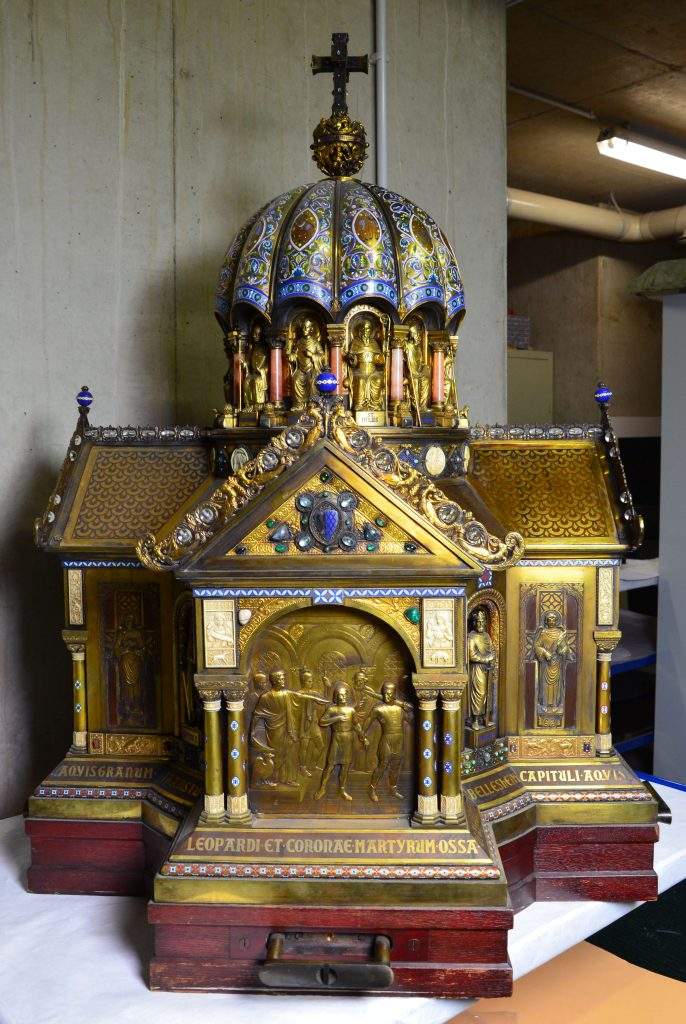In Germany, the reliquary of Santa Corona, made in the early 20th century and kept in Aachen Cathedral, has undergone an extraordinary cleaning operation. The operation had been planned for some time as the reliquary will be featured in an exhibition of historical goldsmithing scheduled to open in the summer (and it is interesting to note that it had not been on public display for twenty-five years), but now its display takes on special significance, given the saint’s name and given the name of the virus that is causing the global health emergency. “We intervened on the reliquary a little earlier than we had planned,” a spokeswoman for the Cathedral, Daniela Loevenich, told Reuters news agency, “and now we expect more interest because of the coronavirus.”
From the Cathedral they let it be known that Saint Crown is the patron saint of epidemics (although there are actually few attestations to this effect), and consequently, said Aachen Cathedral Treasury Director Brigitte Falk, “Saint Crown, like other saints, can be a source of hope in these difficult times.” According to hagiography, St. Corona was martyred on May 14 of the year 171 in Syria: she was 16 years old, the wife of a comrade of St. Victor (the legionary saint who suffered martyrdom with her and is usually venerated together with St. Corona) and was killed by quartering (she was tied to two palms previously bent and held still, which, once left, would martyr the young woman’s body to resume their position).
Also according to legend, Corona’s relics were allegedly brought from Syria to Aachen by King Otto III in 997, and kept in a tomb beneath the Cathedral: it was not until 1911 that they were placed in the temple-shaped reliquary, a work 93 centimeters in height and 98 kilograms in weight. The work was specially made that year (and finished in 1912), after the 1910 excavations that led to the rediscovery of the relics: the precious work of goldsmithing was created by Bernhard Witte (Aachen, 1868 - Schwarzrheindorf, 1947), one of the most prominent goldsmiths in early 20th-century Germany. These days the work has been disassembled piece by piece to allow restorers to conduct the cleaning work as best they can.
The reliquary was made in the form of a Byzantine church with a Greek cross plan and surmounted by a dome consisting of twelve pieces, all richly decorated. The “façade” of the small temple also has arches with columns bearing ivory bases, where a number of reliefs depicting the stories of the relics are inserted: one can see the martyrdom of the saint, the transport of the relics at the hands of Otto III, and the excavation of the Cathedral in 1910 at the behest of the Cathedral’s provost, historian Alphons Bellesheim.
Now the Cathedral is also thinking about a permanent exhibition, which in recent years had not been deemed necessary because of the lack of interest in works from the medieval revival that affected Europe in the late 19th and early 20th centuries. Given the renewed attention now being paid to these artistic productions as well, however, it is not certain that the reliquary of St. Crown could not become an object constantly on public display. From the Cathedral, however, they let it be known that the necessary exhibition apparatus, currently absent, will have to be put in place.
 |
| Aachen Cathedral dusts off St. Crown reliquary. May give hope for coronavirus |
Warning: the translation into English of the original Italian article was created using automatic tools. We undertake to review all articles, but we do not guarantee the total absence of inaccuracies in the translation due to the program. You can find the original by clicking on the ITA button. If you find any mistake,please contact us.